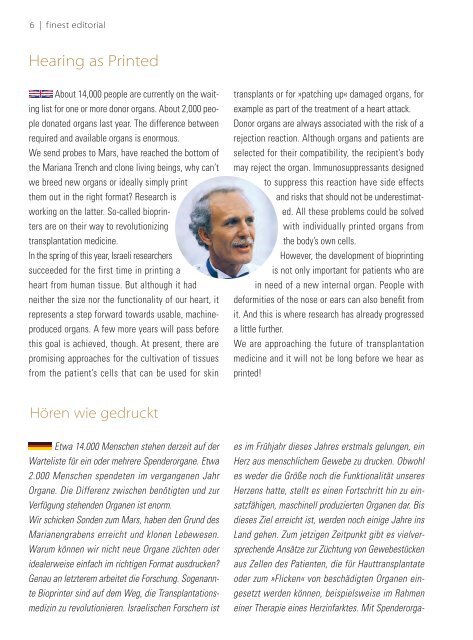»finest« – Marbella III/2019
Create successful ePaper yourself
Turn your PDF publications into a flip-book with our unique Google optimized e-Paper software.
6 | finest editorial<br />
Hearing as Printed<br />
About 14,000 people are currently on the waiting<br />
list for one or more donor organs. About 2,000 people<br />
donated organs last year. The difference be tween<br />
required and available organs is enormous.<br />
We send probes to Mars, have reached the bottom of<br />
the Mariana Trench and clone living beings, why can’t<br />
we breed new organs or ideally simply print<br />
them out in the right format? Research is<br />
working on the latter. So-called bioprinters<br />
are on their way to revolutionizing<br />
transplantation medicine.<br />
In the spring of this year, Israeli re searchers<br />
succeeded for the first time in printing a<br />
heart from human tissue. But although it had<br />
neither the size nor the functionality of our heart, it<br />
represents a step forward towards usable, machineproduced<br />
organs. A few more years will pass before<br />
this goal is achieved, though. At present, there are<br />
promising approaches for the cultivation of tis sues<br />
from the patient’s cells that can be used for skin<br />
transplants or for »patching up« damaged organs, for<br />
example as part of the treatment of a heart attack.<br />
Donor organs are always associated with the risk of a<br />
rejection reaction. Although organs and patients are<br />
selected for their compatibility, the recipient’s body<br />
may reject the organ. Immunosuppressants designed<br />
to suppress this reaction have side effects<br />
and risks that should not be underestimated.<br />
All these problems could be solved<br />
with individually printed organs from<br />
the body’s own cells.<br />
However, the development of bioprinting<br />
is not only important for patients who are<br />
in need of a new internal organ. People with<br />
deformities of the nose or ears can also benefit from<br />
it. And this is where research has already progressed<br />
a little further.<br />
We are approaching the future of transplantation<br />
medicine and it will not be long before we hear as<br />
printed!<br />
Hören wie gedruckt<br />
Etwa 14.000 Menschen stehen derzeit auf der<br />
Warteliste für ein oder mehrere Spenderorgane. Etwa<br />
2.000 Menschen spendeten im vergangenen Jahr<br />
Organe. Die Differenz zwischen benötigten und zur<br />
Verfügung stehenden Organen ist enorm.<br />
Wir schicken Sonden zum Mars, haben den Grund des<br />
Marianengrabens erreicht und klonen Lebewesen.<br />
Warum können wir nicht neue Organe züchten oder<br />
idealerweise einfach im richtigen Format ausdrucken?<br />
Genau an letzterem arbeitet die Forschung. Sogenannte<br />
Bioprinter sind auf dem Weg, die Transplantationsmedizin<br />
zu revolutionieren. Israelischen Forschern ist<br />
es im Frühjahr dieses Jahres erstmals gelungen, ein<br />
Herz aus menschlichem Gewebe zu drucken. Obwohl<br />
es weder die Größe noch die Funktionalität unseres<br />
Herzens hatte, stellt es einen Fortschritt hin zu einsatzfähigen,<br />
maschinell produzierten Organen dar. Bis<br />
dieses Ziel erreicht ist, werden noch einige Jahre ins<br />
Land gehen. Zum jetzigen Zeitpunkt gibt es vielversprechende<br />
Ansätze zur Züchtung von Gewebestücken<br />
aus Zellen des Patienten, die für Hauttransplantate<br />
oder zum »Flicken« von beschädigten Organen eingesetzt<br />
werden können, beispielsweise im Rahmen<br />
einer Therapie eines Herzinfarktes. Mit Spenderorga-


















